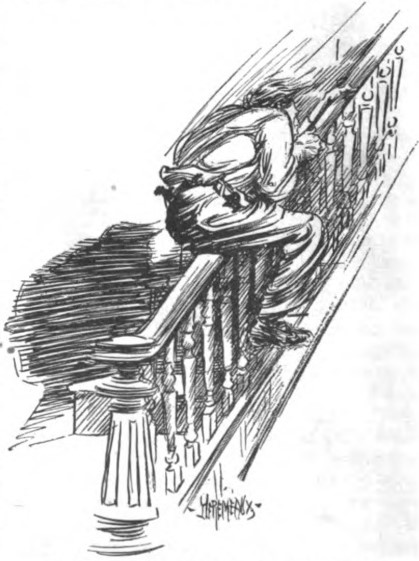"Pugh's Poisoned Ring."
By Richard Marsh (Richard Bernard Heldmann, 1857-1915).
Illustrations by B. E. Minns.
First appearance: The London Magazine, October 1900.
Short story (11 pages, 6 illos).
Online at Hathi Trust (HERE).
"I thought I'd call and tell you, because"—what he meant for a smile grew more pronounced—"that ring is possessed of peculiar properties."
Mr. Tress, a rabid collector of oddities, discovers to his peril that rabidly collecting items without being careful of their origin can not only be a pain, it could also prove fatal . . .
Resources:
- Richard Marsh could take a piece of exotica and spin a story around it. From Wikipedia: "He also published serial short stories, developing characters whose adventures could be related in discrete stories in numerous editions of a magazine. Mr. Pugh and Mr. Tress of Curios: Some Strange Adventures of Two Bachelors [1898; Valancourt Books reprint HERE and HERE; reviews HERE] are rival collectors between whom pass a series of bizarre and discomfiting objects—poisoned rings, pipes which seem to come to life, a phonograph record on which a murdered woman seems to speak from the dead, and the severed hand of a 13th-century aristocrat."
~ ~ ~
RICHARD MARSH HAD several series characters, including an unusual sleuth whom he featured in stories running from 1911 to 1915 in The Strand and other magazines (collection HERE); Wikipedia again: "One of Marsh’s most striking creations is Miss Judith Lee, a young teacher of deaf pupils whose lip-reading ability involves her with mysteries that she solves by acting as a detective."
One of the Judith Lee stories, "The Man Who Cut Off My Hair" (1911), saw reprinting in Alfred Hitchcock's Mystery Magazine (AHMM) thirty years ago. (Data from FictionMags.)
Here is a link to Judith's introductory story—plus a few more; perhaps, after reading these, you might find the character as charming as contemporary readers seem to have:
(1) "The Man Who Cut Off My Hair."
By Richard Marsh (1857-1915).
Illustrations by W. R. S. Stott (1878-1939; HERE).
First appearance: The Strand Magazine, August 1911.
Reprint: AHMM, July 1988.
Short story (10 pages, 4 illos).
Online at Hathi Trust (HERE).
"A new detective method is such a rare thing that it is with unusual pleasure we introduce our readers to Judith Lee, the fortunate possessor of a gift which gives her a place apart in detective fiction. Mr. Marsh's heroine is one whose fortunes, we predict with confidence, will be followed with the greatest interest from month to month."
~ ~ ~
(2) "Eavesdropping at Interlaken."
By Richard Marsh (1857-1915).
Illustrations by J. R. Skelton (1865-1927; HERE).
First appearance: The Strand Magazine, October 1911.
Short story (13 pages, 3 illos).
Online at Hathi Trust (HERE).
~ ~ ~
(3) "Conscience."
By Richard Marsh (1857-1915).
Illustrations by J. R. Skelton (1865-1927; HERE).
First appearance: The Strand Magazine, November 1911.
Short story (12 pages, 5 illos).
Online at Hathi Trust (HERE).
~ ~ ~
(4) "Matched."
By Richard Marsh (1857-1915).
Illustrations by J. R. Skelton (1865-1927; HERE).
First appearance: The Strand Magazine, December 1911.
Short story (12 pages, 4 illos).
Online at Hathi Trust (HERE).
~ ~ ~
(5) "The Miracle."
By Richard Marsh (1857-1915).
Illustrations by J. R. Skelton (1865-1927; HERE).
First appearance: The Strand Magazine, January 1912.
Short story (14 pages, 5 illos).
Online at Hathi Trust (HERE).
~ ~ ~
(6) "Auld Lang Syne."
By Richard Marsh (1857-1915).
Illustrations by J. R. Skelton (1865-1927; HERE).
First appearance: The Strand Magazine, February 1912.
Short story (11 pages, 3 illos).
Online at Hathi Trust (HERE).
. . . which is immediately followed by this non-fiction article:
"Lip-Reading: The Art of Judith Lee."
By C. Sibley Haycock.
Article (6 pages, illustrated).
Online at Hathi Trust (HERE); Wikipedia (HERE).
~ ~ ~ ~ ~
BONUS STUFF
We also found two other of Marsh's criminous stories, both sharing the theme of burglary, in one of his collections, Frivolities, Especially Addressed to Those Who Are Tired of Being Serious (1899):
"The Burglar's Blunder."
First appearance: Unknown.
Online at Project Gutenberg (HERE).
(Note: Two clicks may be necessary to get to this item.)
"The principal cause of failure is that you are too subjective. You have quite one of the most subjective organisations I have yet encountered. The ideal criminal must keep himself abreast with the advance of science."
~ ~ ~
"A Burglar Alarm."
First appearance: The Grand Magazine of Fiction, November 1908.
Online at Project Gutenberg (HERE).
(Note: Two clicks may be necessary to get to this item.)
"I am of a plethoric habit, and by the time I had done all the stooping which Leila thought was indispensable if the burglar alarm was to be all that a burglar alarm ought to be, I was, I am convinced, within a measurable distance of apoplexy."
~~~~~~~~~~~~~~~~~~~~~~~~~~~~~~~~~~~~~~~~~~~~~~~~~~~~~~~~~~~~~~~~~~~~~~~~~~~~
























































